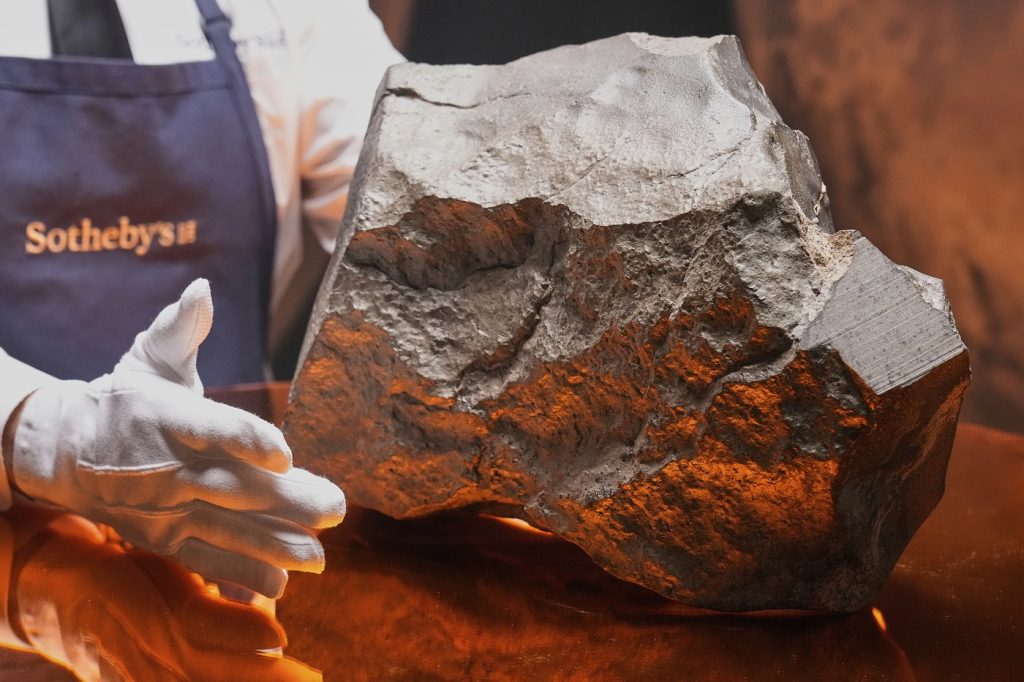NEW YORK (AP) - Up for auction is a remarkable Martian meteorite, weighing 54 pounds (25 kilograms), with an estimated price tag of $2 million to $4 million. This hefty rock, known as NWA 16788, is notable for being the largest piece of Mars discovered on Earth.
Sotheby’s in New York is set to auction this extraordinary specimen on Wednesday, as part of a natural history-themed sale that will also feature a juvenile Ceratosaurus skeleton measuring over 6 feet (2 meters) tall and nearly 11 feet (3 meters) long.
The meteorite in question is believed to have originated from the surface of Mars, blasted away by a massive asteroid impact. It then traversed approximately 140 million miles (225 million kilometers) before crashing into the Sahara Desert. A meteorite hunter discovered it in Niger in November 2023, according to Sotheby’s.
This intriguing rock, characterized by its red, brown, and gray hues, is approximately 70% larger than the next largest Martian meteorite found on Earth and represents nearly 7% of all Martian material currently residing on our planet. With dimensions close to 15 inches by 11 inches by 6 inches (375 millimeters by 279 millimeters by 152 millimeters), its size is exceptional.
Cassandra Hatton, Sotheby’s vice chairman for science and natural history, emphasized the meteorite's uniqueness, stating, “This Martian meteorite is the largest piece of Mars we have ever found by a long shot.” Hatton noted that it surpasses the size of the previously known largest Martian meteorite by more than double.
Rarity further adds to the meteorite’s allure, as there are only about 400 recognized Martian meteorites among more than 77,000 meteorites officially cataloged on Earth. A small sample of the meteorite was sent to a specialized laboratory for testing, which confirmed its Martian origin by comparing its chemical composition to that of Martian meteorites explored by the Viking space probe that landed on Mars in 1976.
Scientific examination revealed that this meteorite is an “olivine-microgabbroic shergottite,” a type of Martian rock formed from the gradual cooling of Martian magma. Notably, it features a coarse-grained texture and contains minerals such as pyroxene and olivine. The meteorite's glassy surface, likely formed from the intense heat experienced as it plummeted through Earth’s atmosphere, served as an initial indicator that it was not just an ordinary rock.
Previously, this Martian meteorite was exhibited at the Italian Space Agency in Rome. Sotheby’s has not disclosed the identity of the current owner, and while the exact date of when the meteorite crashed to Earth remains uncertain, tests suggest it likely occurred in recent years.
In addition to the Martian meteorite, the auction features a juvenile Ceratosaurus nasicornis skeleton, which was unearthed in 1996 near Laramie, Wyoming, at Bone Cabin Quarry, a notable site for dinosaur fossils. The skeleton, comprising nearly 140 fossil bones and some sculpted materials to complete its assembly, is prepared for exhibition and is estimated to fetch between $4 million and $6 million.
Dating back to the late Jurassic period, approximately 150 million years ago, the Ceratosaurus is a bipedal dinosaur with short arms, reminiscent of the larger Tyrannosaurus rex but significantly smaller. While a Ceratosaurus could reach lengths of up to 25 feet (7.6 meters), the famous T. rex could grow up to 40 feet (12 meters).
The skeleton was acquired last year by Fossilogic, a fossil preparation and mounting company based in Utah. The upcoming auction is part of Sotheby’s Geek Week 2025 event, which showcases 122 unique items, including other meteorites, fossils, and gem-quality minerals.










